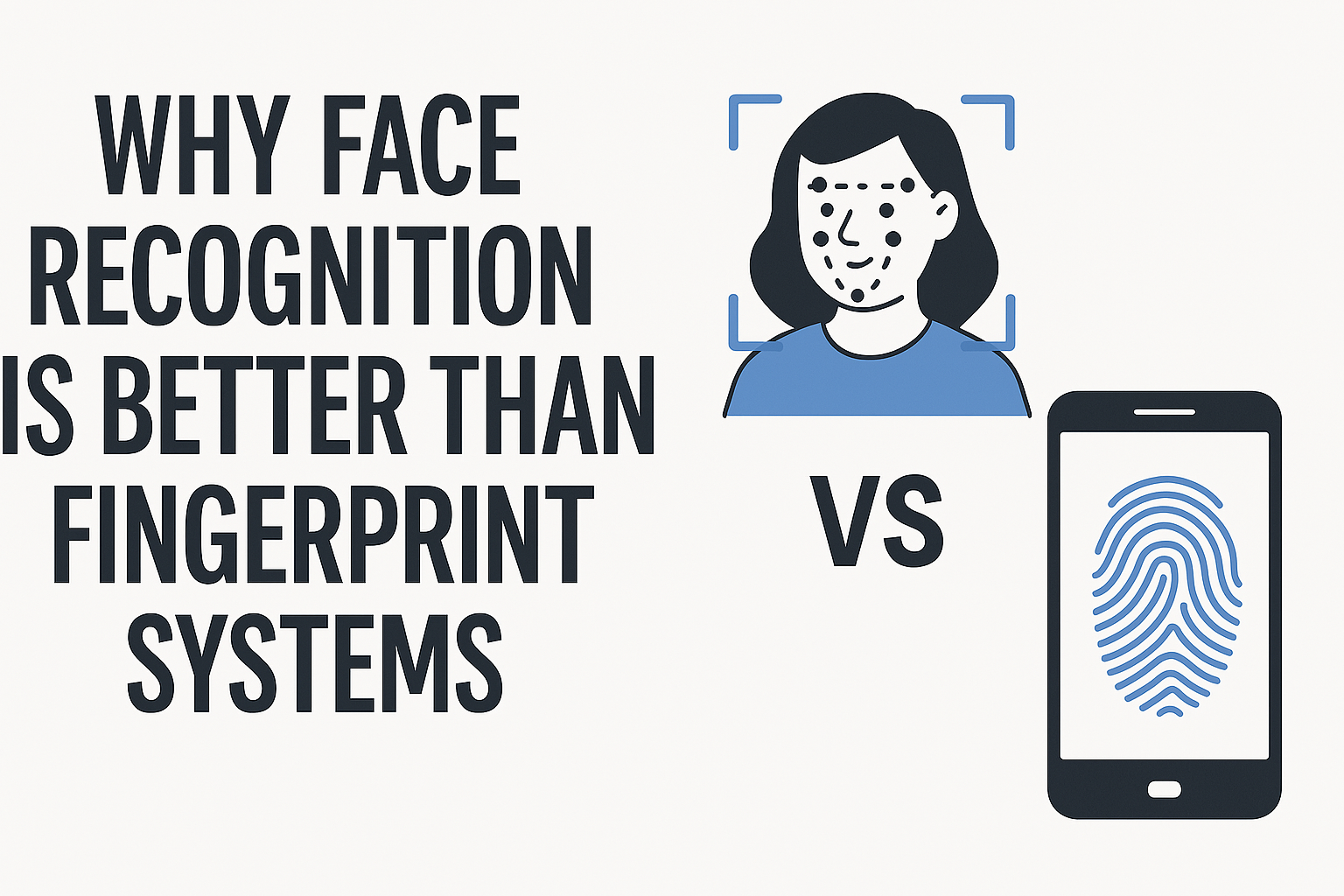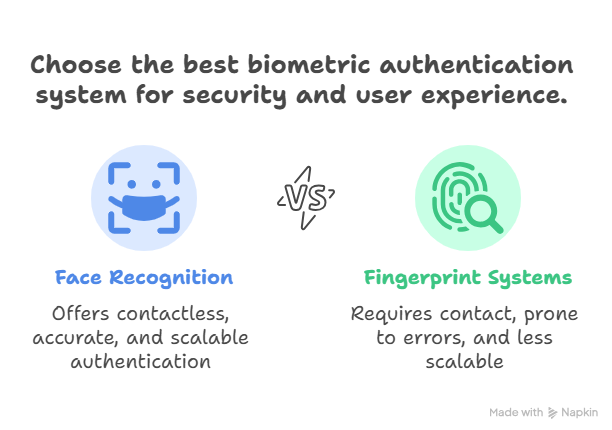
Table of contents
As security becomes increasingly important in today’s world, businesses and individuals are searching for the safest ways to secure sensitive information. One discussion that continues to grow in popularity is: why face recognition is better than fingerprint systems. This article will outline what face recognition and fingerprint systems are in straightforward and engaging way. We will compare both methods, discuss what benefits each system has, and why face recognition is a new, modern and effective way to authenticate a user.
Introduction
Security systems are a cornerstone of technology today. Two frequently used biometric systems are fingerprint recognition and face recognition. While fingerprint recognition has been used for many years, face recognition is an up-and-coming choice for many applications. In this article, we discuss the various reasons that support the case that face recognition is a superior choice than fingerprint systems; we will be discussing security, convenience, accuracy, and technology that favors face recognition.
What Is Fingerprint Recognition?
Fingerprint recognition is a method that uses the unique patterns on your fingertips. These patterns are captured by the sensors and compared with stored data for verification. Fingerprint systems have been used for access control, time tracking, and personal device unlocking. Although they have been trusted for many years, but there are some limitations:
- Hygiene Issues: Multiple people use the same device, increasing the risk of spreading germs.
- Wear and Tear: Finger skin can change over time due to wear, injuries, and environmental factors.
- Sensor Limitations: With low-quality sensors, the system may capture inaccurate patterns.
What Is Face Recognition?
Face recognition is a biometric technology that analyses the unique features of a person’s face. This method converts the face into a digital template and compares it with stored data-templates for verification. Advanced algorithms detect edges, contours, and the spatial relationship between key facial points. In addition, modern face recognition systems use artificial intelligence to improve accuracy over time.
There are several reasons why face recognition is gaining popularity:
- Contactless Process: There is no need to touch a sensor, making it more hygienic and user-friendly.
- High Accuracy: Modern algorithms reduce errors, even when faces change slightly over time.
- Ease of Use: All you need to do is face the camera. It fits easily into everyday routines.
With these benefits, face recognition offers a seamless and secure method of authentication that many users prefer over fingerprints.
Table : Why Face Recognition Is Better Than Fingerprint Systems
Below is a table that highlights key differences between fingerprint and face recognition systems:
| Feature | Fingerprint Systems | Face Recognition Systems |
|---|---|---|
| Hygiene | Requires physical contact; risk of germs | Completely contactless; highly hygienic |
| Accuracy | May suffer from wear, cuts, or smudges on fingers | High precision with advanced algorithms; adapts to changes |
| User Experience | Requires physical touch; can feel intrusive | Fast and natural, simply require facing a camera |
| Environmental Factors | Affected by dirt, moisture, and wear on fingers | Works in various lighting conditions and angles |
| Ease of Integration | Common in older systems; may need upgrades | Easily integrated with IoT devices and mobile platforms |
| Cost Efficiency | Sensor quality can vary, requiring maintenance | More scalable and often more cost-effective over time |
Why Face Recognition Is Better Than Fingerprint Systems in Details

1. Contactless Interaction
Face recognition provides a way for users to authenticate without touching any device. In our current health-conscious society, contactless systems are important. Contactless systems limit the spread of germs and provide the most secure method of authentication. It is simply more “human” to look at a camera. Looking at a camera is the most natural experience for the user.
2. Enhanced Accuracy and Reliability
Today’s face recognition systems utilize advanced machine learning. They can identify someone, even if that person is wearing glasses or hats or appeared slightly altered. Fingerprint systems can fail depending on cuts or scars, or what the operator is using on their fingers. Overall, face recognition is more accurate, making for fewer mistakes and less up-time over time.
3. Better User Experience
Face recognition is fast and intuitive. Users need only to face the camera for a second, and it takes place in almost no time. Because of its simplicity, it is a convenient choice for several applications such as on mobile devices, access control systems and payment systems. Moreover, the notion that this is non-intrusive technology enhances the experience even more.
4. Scalability and Flexibility
Facial recognition can be deployed in a number of different settings, including workplaces, retail stores, airports, and public places. The technology is easily scalable for usage within large companies and organizations. Can work in varying lighting conditions and/or in various weather conditions, providing an adaptable solution. Businesses can benefit from built-in ease of integration, and the ability to customize or adapt the technology for their future needs.
5. Advanced Security
The use of facial recognition is not also useful but also very secure. The details of each face creates a unique digital map. Artificial intelligence continues to enhance the system to detect and stop fraud. This security is the reason facial recognition is an excellent choice for sensitive applications such as banking, access control, or border security.
6. Cost-Effectiveness Over Time
The upfront cost for face recognition may come with a higher initial cost, but often, these long-term costs are lower. Because of less extensive maintenance, fewer errors, and more scalable technology, cost savings are realized. Face recognition offers a greater return on investment over some fingerprint systems that require sensor updates and maintenance after several weeks.
Applications in Various Industries
Face recognition is better than fingerprint systems for many reasons. Its benefits extend across multiple industries:
- Corporate Security: Companies use face recognition to control access to secure areas. It streamlines employee entry while maintaining high security standards.
- Mobile Devices: Smartphones have widely adopted face recognition for unlocking and payments. Its speed and accuracy enhance user satisfaction.
- Retail: Retailers use face recognition to improve customer service. It helps identify loyal customers and tailor personalized experiences.
- Banking and Finance: Financial institutions rely on face recognition for secure user verification. The system prevents fraud and secures transactions.
- Public Safety: Airports and borders employ face recognition to ensure secure and efficient identity verification. It expedites the authentication process, making travel smoother.
These applications demonstrate the wide-ranging impact of face recognition on modern security and user experience.
Future Trends in Biometric Authentication
- Increased Adoption: More industries are expected to adopt face recognition as the main authentication method. Its benefits in security and user experience will drive further growth.
- Integration with IoT: Face recognition will become a key component of smart homes and public spaces. It will link with other devices to create fully integrated security systems.
- Improvements in Accuracy: Ongoing advances in AI will lead to even greater precision. Future systems will handle more diverse environments and challenges effortlessly.
- Enhanced Privacy Measures: As technology develops, so will privacy protections. Stronger encryption and data management will ensure that face recognition remains secure and trustworthy.
These trends suggest that the future firmly favors face recognition over traditional fingerprint systems.
Conclusion
To summarize, face recognition offers several advantages over fingerprint systems for desirable reasons. Its contactless approach, heightened accuracy, enhanced user experience, scalability, improved security capabilities, and cost-effectiveness make it a preferable option for current authentication needs. As industries evolve, face recognition will have a significant position in security, convenience, and operational efficiency.





